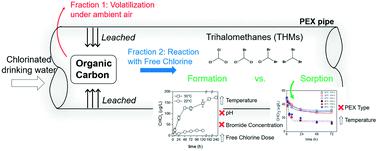当前位置:
X-MOL 学术
›
Environ. Sci.: Water Res. Technol.
›
论文详情
Our official English website, www.x-mol.net, welcomes your
feedback! (Note: you will need to create a separate account there.)
Formation and sorption of trihalomethanes from cross-linked polyethylene pipes following chlorinated water exposure
Environmental Science: Water Research & Technology ( IF 3.5 ) Pub Date : 2020-05-14 , DOI: 10.1039/d0ew00262c Gaopin Cao 1, 2, 3, 4 , Kun Huang 1, 2, 3, 4 , Andrew J. Whelton 1, 2, 3, 4, 5 , Amisha D. Shah 1, 2, 3, 4, 5
Environmental Science: Water Research & Technology ( IF 3.5 ) Pub Date : 2020-05-14 , DOI: 10.1039/d0ew00262c Gaopin Cao 1, 2, 3, 4 , Kun Huang 1, 2, 3, 4 , Andrew J. Whelton 1, 2, 3, 4, 5 , Amisha D. Shah 1, 2, 3, 4, 5
Affiliation

|
In recent years, cross-linked polyethylene (PEX) pipes have become more commonplace in building plumbing. However, their presence can strongly impact water quality by leaching organic carbon and sorbing contaminants, to and from the water supply, respectively. This study assessed how these processes could further impact concentrations of disinfection by-products (DBPs) and specifically trihalomethanes (THMs) when exposed to chlorinated water. One brand of three different PEX types (PEX-a, PEX-b, and PEX-c) were exposed to synthetic water, which was subsequently chlorinated over 120 h under varying water quality conditions (e.g. temperature, pH, bromide concentration, and free chlorine dose). Results indicated that THM formation was fairly modest for all three PEX types at 22 °C but increased by a factor of ∼2 at 55 °C for the PEX-a pipe. Other water quality conditions exhibited more limited effects. Pipe-storage time strongly affected leached organic carbon levels but did not affect THM formation. THM sorption also occurred for all three PEX types and was similarly controlled by temperature. Sorption data fit well to a kinetic adsorption model. Combined effects of THM formation and sorption at 22 °C generated no aqueous phase THMs, although this effect was not similarly examined at 55 °C. These results suggest that sorption may mitigate the effects of THM formation if PEX pipes continue to reside downstream of where formation occurred, but this may not be the case if other pipe types (e.g. metal pipes) are present. Overall, these findings have important regulatory consequences since current THM monitoring may or may not account for building PEX plumbing.
中文翻译:

暴露于氯化水后,交联聚乙烯管道中三卤甲烷的形成和吸附
近年来,交联聚乙烯(PEX)管已在建筑管道中变得越来越普遍。但是,它们的存在会分别通过淋滤有机碳和吸附污染物而严重影响水质。这项研究评估了这些过程如何在暴露于氯化水中时进一步影响消毒副产物(DBP)的浓度,特别是三卤甲烷(THM)的浓度。将三种不同PEX类型(PEX-a,PEX-b和PEX-c)中的一种品牌暴露于合成水中,随后在变化的水质条件下(例如,温度,pH,溴化物浓度和游离氯剂量)。结果表明,在22°C下,所有三种PEX类型的THM形成都相当适中,而对于PEX-a管,在55°C下,THM形成量增加了约2倍。其他水质条件显示出更有限的影响。管道存储时间强烈影响浸出的有机碳水平,但不影响THM的形成。三种PEX类型均发生THM吸附,并且类似地受温度控制。吸附数据非常适合动力学吸附模型。THM形成和吸附在22°C时的综合作用没有产生水相THM,尽管在55°C下未进行类似的检查。这些结果表明,如果PEX管道继续驻留在发生形成的位置的下游,则吸附作用可能会减轻THM形成的影响,例如金属管)。总体而言,这些发现具有重要的监管后果,因为当前的THM监控可能会或可能不会解释PEX管道的建设。
更新日期:2020-05-14
中文翻译:

暴露于氯化水后,交联聚乙烯管道中三卤甲烷的形成和吸附
近年来,交联聚乙烯(PEX)管已在建筑管道中变得越来越普遍。但是,它们的存在会分别通过淋滤有机碳和吸附污染物而严重影响水质。这项研究评估了这些过程如何在暴露于氯化水中时进一步影响消毒副产物(DBP)的浓度,特别是三卤甲烷(THM)的浓度。将三种不同PEX类型(PEX-a,PEX-b和PEX-c)中的一种品牌暴露于合成水中,随后在变化的水质条件下(例如,温度,pH,溴化物浓度和游离氯剂量)。结果表明,在22°C下,所有三种PEX类型的THM形成都相当适中,而对于PEX-a管,在55°C下,THM形成量增加了约2倍。其他水质条件显示出更有限的影响。管道存储时间强烈影响浸出的有机碳水平,但不影响THM的形成。三种PEX类型均发生THM吸附,并且类似地受温度控制。吸附数据非常适合动力学吸附模型。THM形成和吸附在22°C时的综合作用没有产生水相THM,尽管在55°C下未进行类似的检查。这些结果表明,如果PEX管道继续驻留在发生形成的位置的下游,则吸附作用可能会减轻THM形成的影响,例如金属管)。总体而言,这些发现具有重要的监管后果,因为当前的THM监控可能会或可能不会解释PEX管道的建设。











































 京公网安备 11010802027423号
京公网安备 11010802027423号